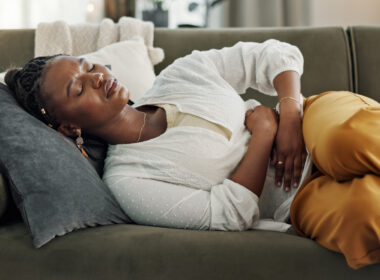I previously addressed a TIME magazine article arguing that modern sports weren’t designed for the female body, especially the adolescent female body. Author and elite female athlete Lauren Fleshman spelled out the health risks girls and young women in particular may face because athletic competition doesn’t take into account their female design. So what’s the solution? How can sports respect the female body?
Fleshman explained:
“If women and girls were placed in sporting environments built around the norms of female puberty and female improvement trajectories, if their bodies were respected and encouraged to develop in their own time, outcomes for women would be entirely different. We can utilize the research on female athletes to drive change, and we must.”
Coaches, including male coaches, need to understand menstrual cycles and health in relation to athletic performance
How specifically can we ensure our female athletes are healthy? We have to talk openly about menstrual cycles and hormones. Fleshman addresses the awkwardness that many (especially male) coaches feel discussing periods and feminine health with their players. This is part of the problem, Fleshman says.
Here at Natural Womanhood we are all for normalizing the discussion of periods and how they are necessary for a woman’s health. However, it’s also important to add that the potential difficulties female athletes face go beyond just the developmental changes of puberty. They also carry into every cycle they experience as adults.
The potential difficulties female athletes face go beyond just the developmental changes of puberty. They also carry into every cycle they experience as adults.
Hormonal health and athletic performance
Many experts in the field of sports medicine are interested in learning more about the hormonal shifts during the menstrual cycle as another factor in female athletic performance. Ellen Casey, MD, co-director of the Penn Center for Female Athletes, discussed how the current phase of a woman’s cycle can change her pain level and pain perception, which can affect her performance. “The bottom line is that hormonal shifts that drive the menstrual cycle can affect multiple parts of the body, including muscle, bone, endurance, energy levels, and attention,” she said.
According to Casey, this variability in performance and health for female athletes poses challenges for physicians. Due to the individualized nature of hormones, some women will experience stronger hormonal shifts than others. This matters because injuries like ACL tears or Runner’s Knee can happen more often during hormonal changes. More research is needed to determine the exact reason(s) why the muscles, tendons, and ligaments in the female body change during times of hormonal shifts and become more sensitive to physical stress and injury. Coaches need to be aware of what is—and isn’t yet—understood about women’s athletic performance in relation to their cycles.
Is birth control the solution to female athletes’ cyclic hormonal shifts?
Given that, as this NaPro-trained doctor put it, women’s bodies “attempt to run the equivalent of a marathon every month” just to ovulate, some coaches and athletes themselves may wonder, wouldn’t it be better to just get rid of their cycle with birth control?
According to a systematic review (i.e., a summary of many studies) on the topic, women who take oral contraceptives experience slightly inferior athletic performance compared to naturally cycling women [1]. One specific area which shows a much wider chasm between cycling women and women on birth control is the building of lean muscle mass with strength training. This study published in the Journal of Strength and Conditioning Research took place over the course of a 10-week training period, and showed that the women on the Pill put on 40% less muscle mass than the women who were not taking birth control [2]. Sarah E Hill, PhD and author of This is Your Brain on Birth Control, hypothesizes that the changes most likely come down to the “differences in testosterone between hormonal contraceptive users and natural cyclers.”
Does the concept of cycle syncing keep women from being active?
Despite growing interest in research surrounding female athletic performance throughout the different phases of the cycle, there are some who say that basing workouts around the cycle— as the World Cup-winning 2019 U.S. Women’s National soccer team did— is a barrier to women becoming active. As an example, this analysis focused largely on the studies about how strength is affected by hormonal changes during a woman’s cycle, and generally found that studies either showed a small impact or none, depending on the population tested. Interestingly, one of the studies the author cites actually did show a statistically significant increase in strength when the women tested were mid-cycle and near ovulation, which is also when levels of testosterone peak [3][4].
Does learning where a woman is in her cycle have to be expensive and time-consuming?
The author contends that although there are some cycle-related performance differences shown by this small number of studies, training athletes according to their cycles is not a great idea. Her reasoning? Not every woman has a 28-day cycle, so how could she possibly know what phase she’s in if she’s not doing expensive and time-consuming hormonal testing?
Fertility awareness methods are an inexpensive, relatively painless, way to teach women to cycle sync—for athletic performance or other reasons
Luckily, there is a way for women to find out what phase of their cycles they’re in without any expensive blood testing: Fertility Awareness Methods. Many of these methods are cheap or even free, and take less time than brushing your teeth in the morning. Even if you’re not an elite athlete and are just looking to improve your workout routine or be a little more mindful of your body’s natural rhythms, knowing when you are moving through each phase of your cycle can be an immense benefit—the U.S. Women’s National team certainly agrees!
Does cycle syncing resolve all the concerns Fleshman expresses about female athletic participation at the elite level?
Ultimately, Fleshman maintains, super-competitive sports were simply not designed with the female body in mind. The expected linear progression of elite athletics performance disregards the fluctuations in an adolescent girl’s development. What’s more, the lack of knowledge of what a healthy female body looks like can lead to energy deficiencies and eating disorders that can physically affect a woman through all stages of her life.
But where does that leave the rest of us, average Janes simply seeking to maintain an active lifestyle for general health purposes? Encouraging girls to be active and involved in team sports can be beneficial for many aspects of both their physical and social health. But it’s necessary for us to take a closer look at how these sports are structured on the girls’ teams versus the boys’. This happens not only by allowing girls to “develop in their own time,” as Fleshman states, but also by encouraging women (and their coaches!) to learn how their cycles affect their health, and understand why putting a pause on their natural hormones with birth control is also not the answer to a healthy, active life.
References:
[1] Elliott-Sale, Kirsty J et al. “The Effects of Oral Contraceptives on Exercise Performance in Women: A Systematic Review and Meta-analysis.” Sports medicine (Auckland, N.Z.) vol. 50,10 (2020): 1785-1812. doi:10.1007/s40279-020-01317-5 [2] Riechman, Steven E.1; Lee, Chang Woock2. Oral Contraceptive Use Impairs Muscle Gains in Young Women. Journal of Strength and Conditioning Research 36(11):p 3074-3080, November 2022. | DOI: 10.1519/JSC.0000000000004059 [3] Sarwar R, Niclos BB, Rutherford OM. Changes in muscle strength, relaxation rate and fatiguability during the human menstrual cycle. J Physiol. 1996 May 15;493 ( Pt 1)(Pt 1):267-72. doi: 10.1113/jphysiol.1996.sp021381. PMID: 8735711; PMCID: PMC1158967.[4] R Atukorala K.,Silva W.,Amarasiri L., D., Changes in serum testosterone during the menstrual cycle – an integrative systematic review of published literature, GREM Gynecological and Reproductive Endocrinology & Metabolism (2022); 01/2022:009-020 doi: 10.53260/grem.223012Additional Reading:
Cycle Syncing: How to hack the natural hormonal shifts of your menstrual cycle











